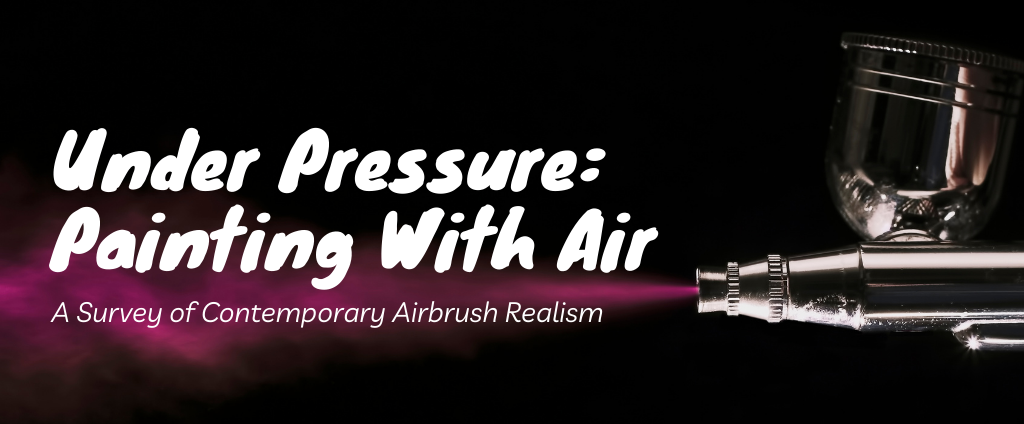
Meet the artists featured in the exhibition, Under Pressure: Painting with Air – A Survey of Contemporary Airbrush Realism, organized by David J. Wagner, LLC. This week we will highlight four more of the artists on display. These artists come from all across the United States and beyond. Their works, wide-ranging in theme, all feature airbrush as the principle medium of expression.
Bruce Evans
Philadelphia, PA
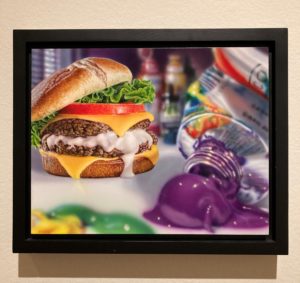
Bruce Evans, Studio XX (Burger), 2019, acrylic on board, 11 x 14 in.
For the past 35+ years, using a brush, airbrush, and artistic sensibilities rooted in Photorealism and Surrealism, Evans has been painting detailed landscapes, cityscapes, animals and still-life arrangements that engage and stimulate the viewer’s imagination. His works are included in numerous private and corporate collections, and his paintings have been exhibited in museums and galleries nationally and internationally.
Artist Statement:
On some level, I am always painting. A walk in the woods, a round of golf (could explain why I’m not better), a conversation with a friend, or just staring out of the window, the door is always open for an idea that inspires the next work. Once an idea takes shape, the painting is executed with hyper-focused attention to lighting and detail, with every hair in place, every curve, and every glint of shadow exactly as nature demands. I know the work is going well if, during the process, I lose all sense of time and self. Painting is just one of many ways to communicate ideas. Some people express their imaginative thoughts through writing, I paint.
George Green
Portland, OR
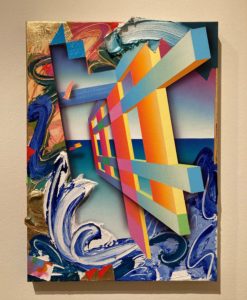
George D. Green, Neskowin Spring II, 1991, acrylic on canvas, 30.75 x 22.5 in.
A founder of the Abstract Illusionist movement that emerged in the 1970s, George Green is widely recognized for his non-objective paintings that incorporated layered geometric elements which appeared to hold three-dimensional space. Created across the span of his fifty-year career, Green’s work continually evolved, becoming more vivid and multidimensional over time as he ventured ever deeper into the realm of trompe l’oeil.
Green had more than sixty-three solo shows in major galleries in the United States, France, and Sweden. He participated in ninety-four group shows and exhibited his work in the U.S., France, Sweden, Belgium, Canada, and England. More than eighty books, articles, and publications include his artwork and writings about him and his work. He is included in the collections of seventy-one museums and public collections including the Guggenheim, the Los Angeles County Museum of Art, and the Art Institute of Chicago. A few years before his passing, he founded the George D. Green Art Institute in Portland.
Artist Statement:
My pictures are painted using multiple systems of pictorial space. Mainly, I combine horizon seeking perspective with shallow space trompe l’oeil. This creates a very believable illusion which doesn’t break down, even when the picture plane is touched. I like combining exuberant, gestural fat paint with precise, high definition trompe l’oeil and heartbreaking, cornball romanticism. And if the paintings turn out to be ironically beautiful, (“pretty as a picture”), so much the better. Aside from all this, many of my works appear to be carefully planned. They’re not. There is never any particular plan or goal—no pre-determined expectation. Each painting is its own surprise. This process is very nearly a direct path into the intuitive mind. It’s a lot of automatic activity and for sure, no judgments permitted while in flow. Only full speed ahead. It’s a painterly dive into a zone where all stuff is discoverable and most things allowed. Yes, I realize some will see this only as a personal opinion—untested by scientific rigor. But this is not the case. I have a bachelor’s degree in science from the U of O and through many years of personal experimentation and research, I know all this to be true. It’s the science of the angels.
Kirk Lybecker
Portland, OR
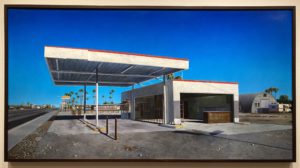
Kirk Lybecker, Every Dream as Misdirection, 2014, oil and acrylic, 38 x 72 in.
Artist Statement:
I don’t think of myself as a photorealist, I tend to think of myself as using photography for it’s ability to remember detail. As much as there is new media, photography is still the lingua franca of the visual world. The point of the work is to make a painting that uses photography for its benefit and paint for its benefit.
I do like a painting that is vague. I want something that I would wonder about long after the paint is dry. What was I thinking?
I am a big fan of drawing. Photography does a lot to order objects but it does not do a great job of either changing them or giving context. The only way to rearrange the structure of a work is through drawing. I also think that if I did not have to, I would never have put down a pencil to pick up a brush.
There seems so little about what I do that I can say. I think of myself as an intuitive painter. There are situational things that just appeal to me. I do have a taste for things in transition though it is rarely in the upward direction. I do not think of my work as a metaphor for the decline but rather the change to things unforeseen. Thinking of it more as the disappointment of the new.
Speaking of the unforeseen, most of what I do comes as a surprise. It does not seem odd that the pursuit of technical mastery gives no clue to the eventual weight of emotional content. So I find myself working on the things that I can control and which I like to do. Painting as a puzzle with no clearly defined rules no consistent method of solution (possibly no method of solution at all) and certainly no clear end.
Jerry Ott
Albert Lea, MN
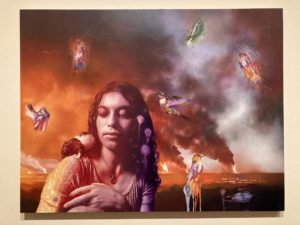
Jerry Ott, Study for Ann’s Obsession (Birds in Gilded Cages), 2014, acrylic on panel, 40 x 52 in.
Artist Statement:
When I first began making these paintings in the late ’60s, it represented a logical progression from the Pop Art related work I had been doing since I began painting. Realism as such was all but unheard of in any sophisticated mode and any realistic imagery based on photography bordered on sacrilege. This was prior to terminology being coined such as “Sharp Focus Realism,” or “Superrealism,” and finally the name that stuck, “Photorealism.”
After showing for many years as an early “Photorealist” and a “Figure Painter” in major shows of the period, I became aware that only a small part of my feelings about painting were shared with other “Photorealist” painters; their work being cool and devoid of emotional content while mine tended to lean toward more visceral or emotional issues and conventional figure painting seemed to be time worn and showing its age. These feelings have never left me and I find myself now involved and reflecting upon the same dilemma, striving to do paintings that excite me and fulfill my needs while enabling me to express my feelings in visual terms.

